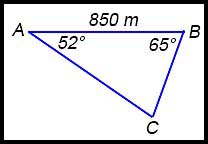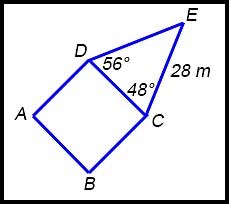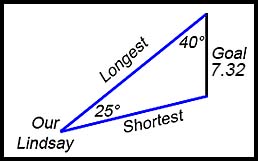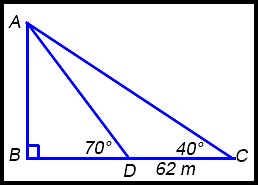Where the techniques of Maths
are explained in simple terms.
Trigonometry - Sine rule.
Test Yourself 1.
- Algebra & Number
- Calculus
- Financial Maths
- Functions & Quadratics
- Geometry
- Measurement
- Networks & Graphs
- Probability & Statistics
- Trigonometry
- Maths & beyond
- Index
| The questions based on the Sine Rule below relate to: |
| 1. The marking of a triangle. |
| 2. Finding the length of a side. |
| 3. Finding the size of an angle. |
| 4. Applied questions. |
| Answer the questions below correct to 2 decimal places unless otherwise indicated | ||
| Marking up the triangle. | Copy both of the following diagrams. Draw arrows to link the angles and sides to be used for each when applying the sine rule. | |
1. 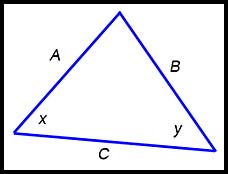 |
2.  |
|
| Basic - find the length of a side (answer to 2 dps). . |
3.
Find A. Answer.A = 9.15. |
4. 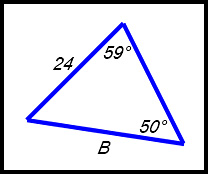
Find B. Answer.B = 26.85. |
5. 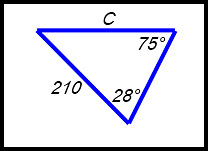
Find C. Answer.C = 102.07. |
6. 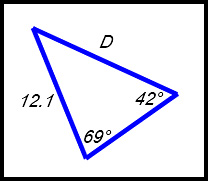
Find D. Answer.D = 16.88. |
|
7. 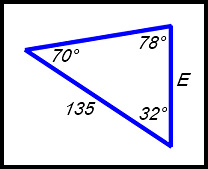
Find E. Answer.E = 129.69. |
8. 
Find F. Answer.F = 16.38. |
|
| Side not opposite | 9. 
Find Z. Answer.Z = 20.61. |
10. 
Find a. Answer.a = 45.53. |
11. 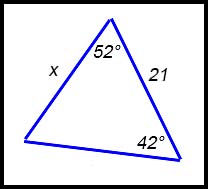
Find the length of the side marked x. Answer.x = 14.09. |
12. 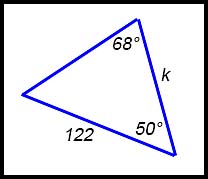
Find the length of the side marked k. Answer.k = 116.18. |
|
| 13. ABC is a triangle in which ∠ABC = 30°, ∠ ACB = 45° and AC = 8 cm.
Find the exact length of AB. Answer.AB = 8√2 cm. |
||
| 14. IJK is a triangle in which ∠JIK = 72.7°, ∠IKJ = 50.1° and JK = 12 cm. (i) Draw a diagram to show this information. (ii) Calculate the length of IJ to the nearest millimeter. Answer.IJ = 9.6 cm. |
||
| 15. A walking track is laid down in a nearby park. The published dimensions are as shown in the diagram below.
(i) Find the length of the track betweenAnswer.(i) BC = 752 m. (ii) Total = 2,467 m. |
||
| 16. Brett is building his house underground so it is not subject to attack from the next bushfires. In one part of the existing underground structure he has dug out a square room ABCD. He now wishes to extend that room further in the shape of a triangle (to lessen the amount of dirt he has to move) to create the open space ABCED.
He digs a wall from D to E at an angle of 56° to DC. On the other side he digs a 28 m wall CE at an angle of 48° to DC.
|
||
| Basic - find the size of an angle. | 17. 
Find a to the nearest minute. Answer.a = 73° 15'. |
18. 
Find θ to the nearest degree. Answer.a = 48°. |
19. 
Find θ to the nearest minute. Answer.a = 61° 1'. |
20. 
Find d to the nearest minute. Answer.a = 29° 46'. |
|
21. 
Find β to the nearest degree. Answer.a = 49°. |
22. 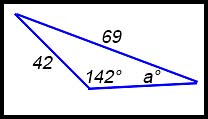
Find a° to the nearest degree. Answer.∠ MLN = 22°. |
|
| Angle not opposite. | 23. 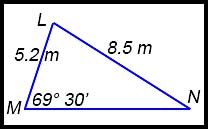
Find the size of ∠ MLN to the nearest minute. Answer.∠ MLN = 75° 32'. |
24. 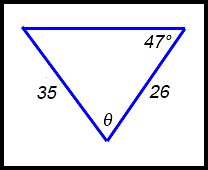
Find the size of the angle θ to the nearest degree. Answer.θ = 100°. |
| The ambiguous case. | 25. 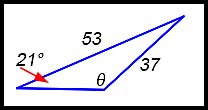
Find the size of the obtuse angle θ. Answer.θ = 149° 7'. |
26. 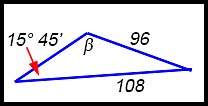
Find the largest value for β in the triangle above. Answer.β = 162° 13'. |
27. 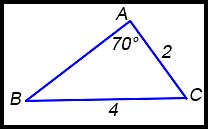
Is it possible for the angle at B to be either acute or obtuse? Answer.Only acute - ∠B = 28° 1'. |
28. 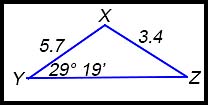
Find the size(s) of ∠XZY |
|
29. 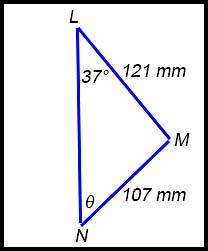
(i) Find the possible value(s) for θ (to the nearest degree). (ii) Draw sketch(es) showing all angles in the triangle(s). Answer.θ = 43° or 137°. |
30. There are two triangles each having sides of 10 cm and 5 cm. The angle opposite the side of length 5 cm in both triangles is 25°.
(i) Find the size of the angle opposite the side of length 10 cm in each triangle (to the nearest degree). (ii) Draw the two triangles showing the given sides and all angles. Answer.Angles are 58° or 122°. | |
| Applied | 31. Lindsay is playing soccer and has a free kick at goal. The goal posts are of the standard width of 7.32 m.
She measures the angle from her to the two posts at 25°. The goal keeper estimates the angle from the furthest upright to Lindsay is 40°. These details are summarised in the diagram below.
Calculate the shortest and longest distances Lindsay must kick the ball if she is to score (to the nearest cm). Answer.Shortest: 11.13 m.Longest: 15.70 m. |
|
| 32. In the triangle shown below
∠BDA = 70°, ∠DCA = 40° and DC = 62 m. Answer.AB = 74.90 m. |
||
| 33. David is playing golf on a hole which is 180 m long.
He mis-hits the ball and it travels at an angle of 25° to the right. His ball is then 45 m short of the hole.
|
||
